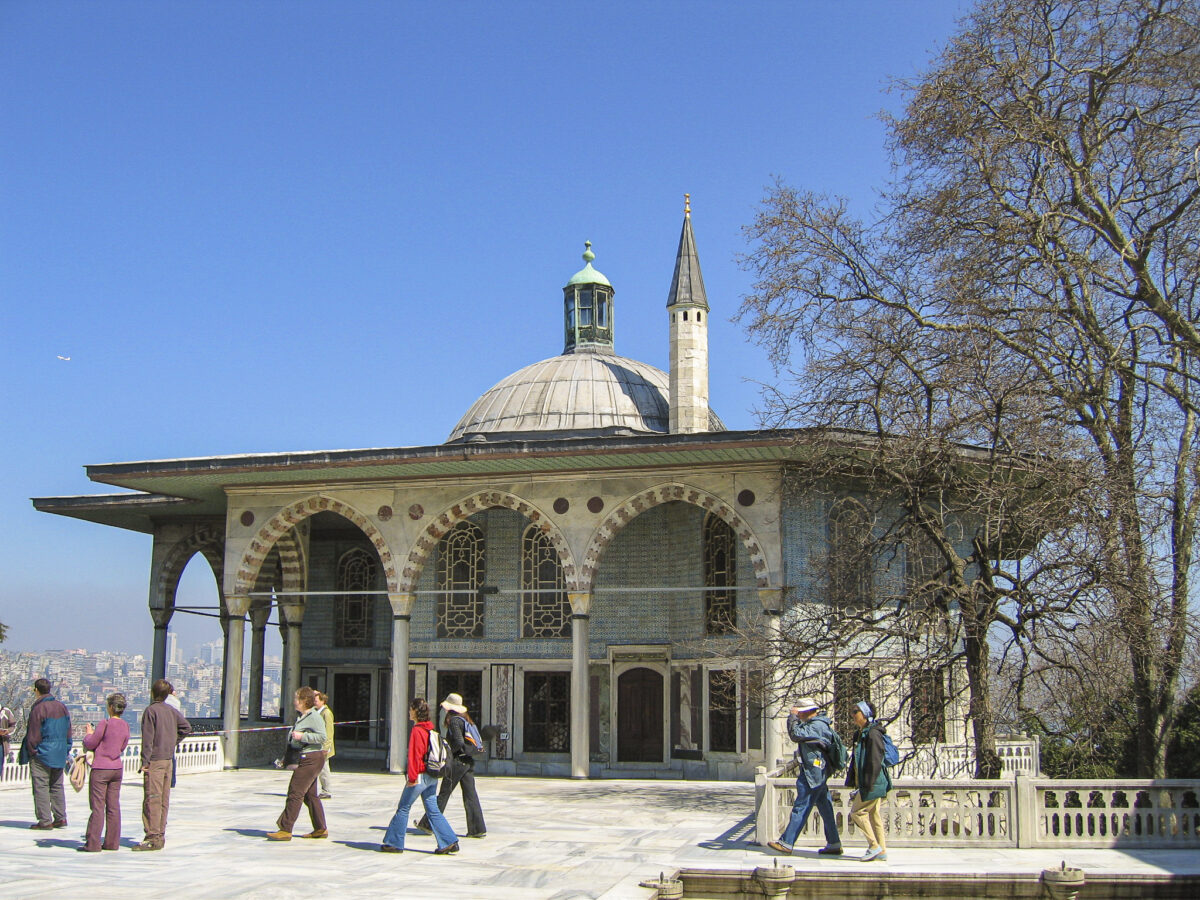I’m dealing with the Harem together with the Third and Fourth Courtyards because they were in a sense integral, although the Harem was also a sequestered section of the palace where, except for members of the royal family, only women and eunuchs were allowed to tread. Although non-castrated males were allowed into parts of the Third and Fourth Courtyards, they and the Harem were all considered the private domain of the Sultan and his family.
The Gate of Felicity (Bâbüssaâde) provided entrance to the Third or Inner Courtyard. It was also known as the Gate of the White Eunuchs. No one, not even the Grand Vizier, was allowed to pass through this gate without the express permission of the Sultan. It is believed to have first been built in the reign of Mehmet II the Conqueror, mid-15th century, but was renovated in the rococo style in 1774.
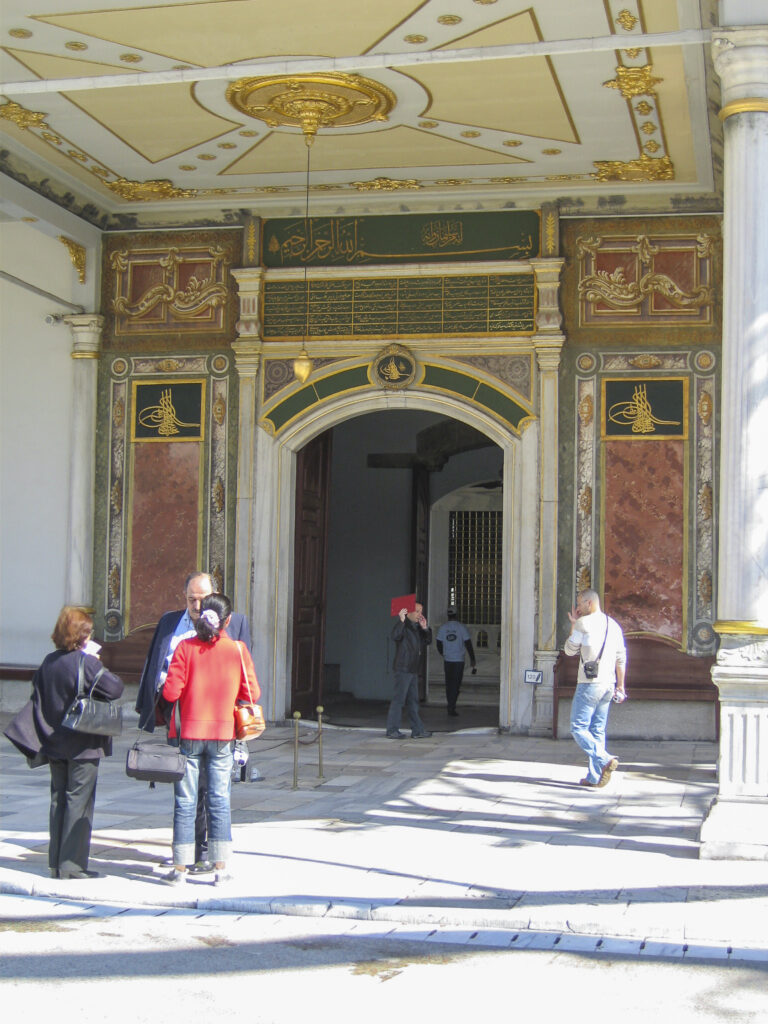
Directly behind the Gate of Felicity stands the Arz Odası, or Chamber of Petitions. This contained the Sultan’s Audience Chamber, or throne room if you will. Originally built in the 15th century, it was destroyed in a fire in 1856 and rebuilt afterward. It is a square kiosk with an overhanging roof supported by 22 columns.
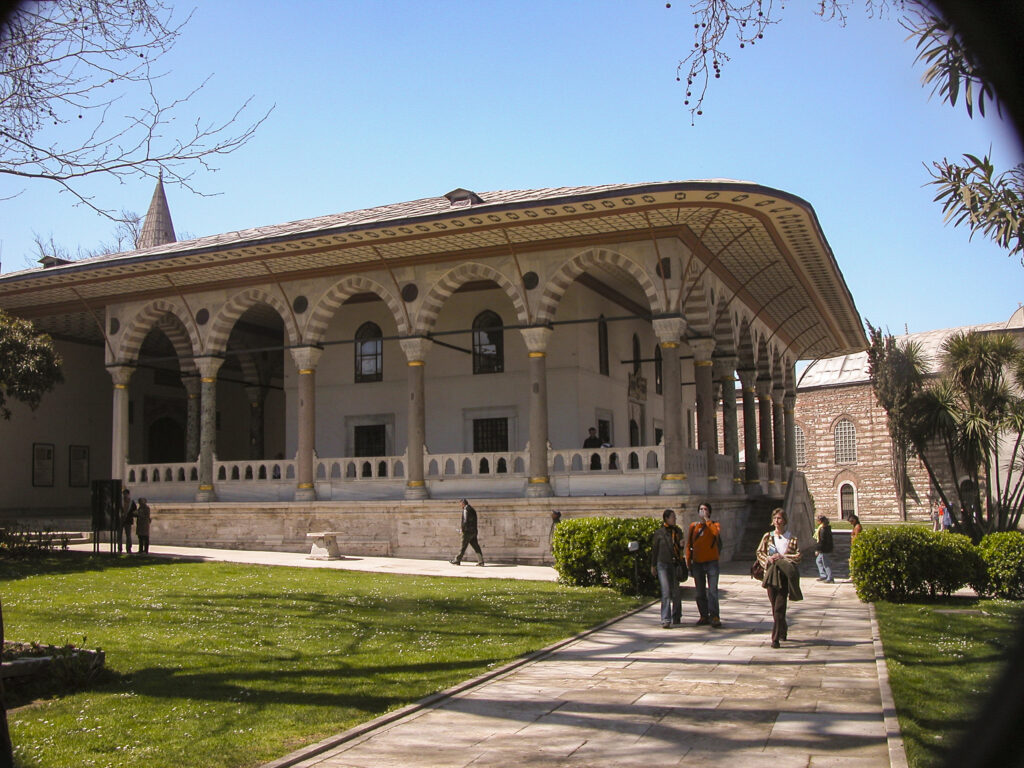
Above the main entrance to the Arz Odasi is an Arabic inscription reading “In the Name of God the Compassionate, the Merciful.” On the left side of the doorway providing entry to the Arz Odası was a window where ambassadors and others turned over the gifts they brought for the Sultan. On the right was a drinking fountain, an addition of Suleiman the Magnificent, with an inscription in Persian declaring that the Sultan is “the fountainhead of generosity, justice and the sea of beneficence.” It neglects to mention that the Sultan could have you garroted on a moment’s notice, as Suleiman did with his Grand Vizier, Ibrahim Pasha, in 1536.
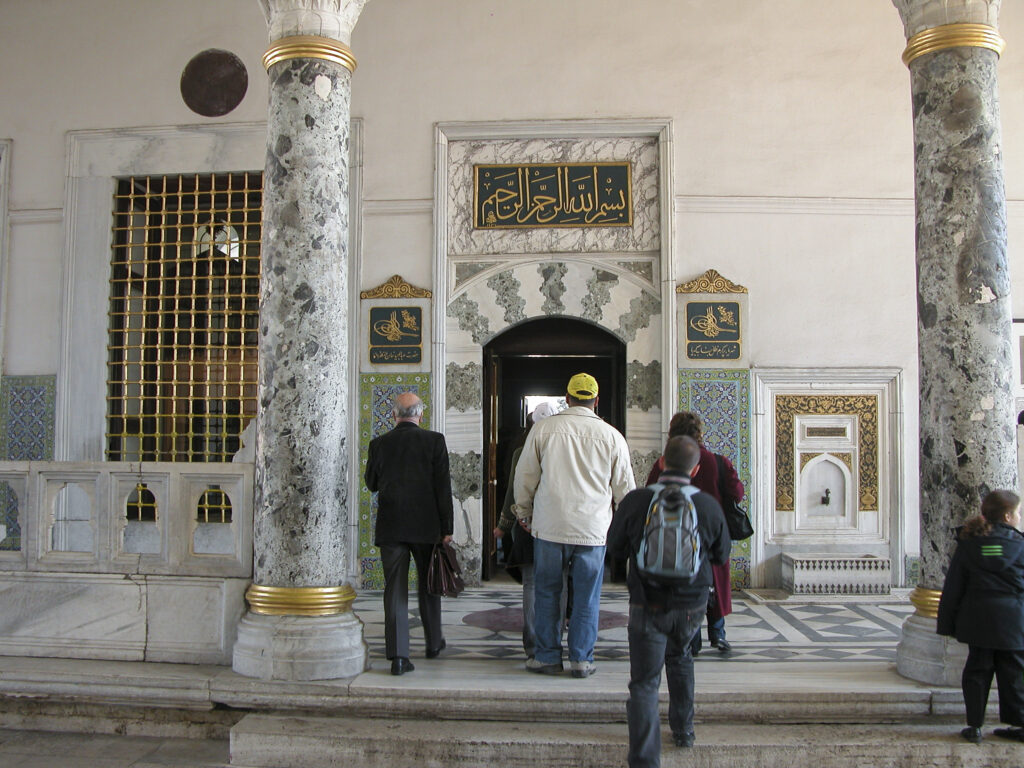
In the Third Courtyard we also saw the Pavilion of Mehmed the Conqueror, which housed the Imperial Treasury. Actually there were two treasuries in Topkapi Palace, an Outer and an Inner. The Outer Treasury, located in the Second Court, was built around the end of the 15th century and was the one that financed state administrative expenses. It now houses a collection of arms and armor. The Inner Treasury, pictured below, was built earlier, around 1460, in the reign of Mehmed the Conqueror — it is in fact one of the oldest Topkapı structures. The Inner Treasury paid the expenses of the palace, which of course were much larger and more important than those of the government administration. Nowadays the Conqueror’s Pavilion houses a vast collection of Ottoman art, jewelry and heirlooms. Among other items, these include the Topkapı Dagger, the object of the heist depicted in the 1964 movie Topkapi, one of my all-time favorite films.
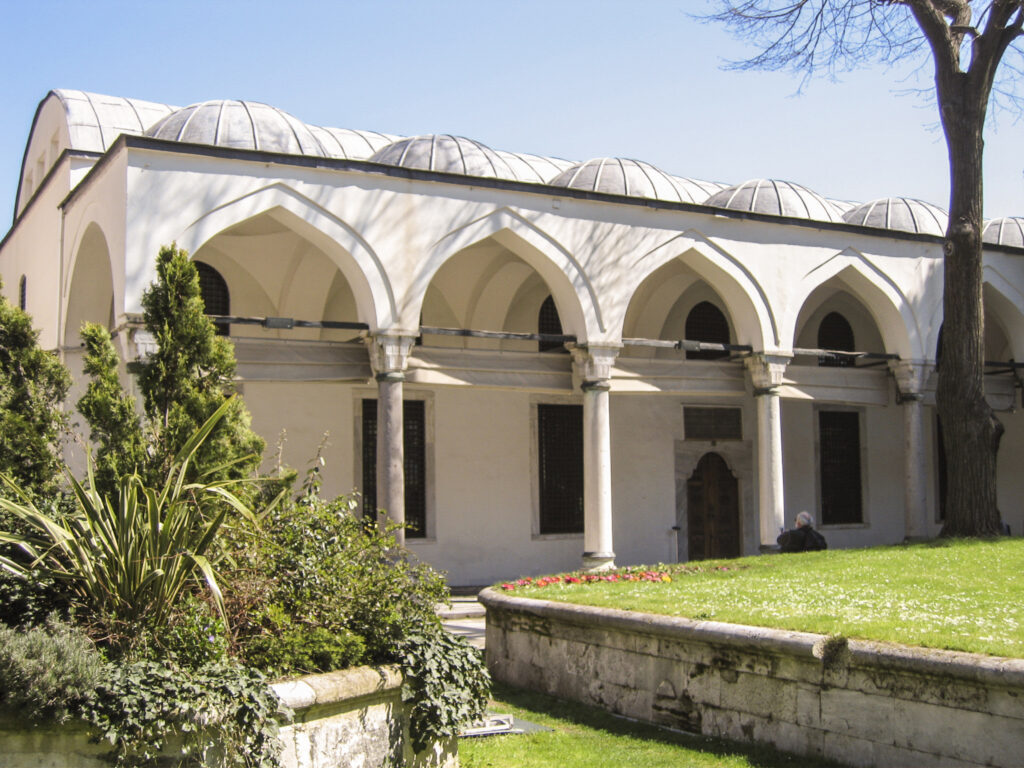
Another legacy of the early days of the Topkapi Palace is this large sundial, dating from sometime in the reign of Mehmed the Conqueror, who died in 1481.
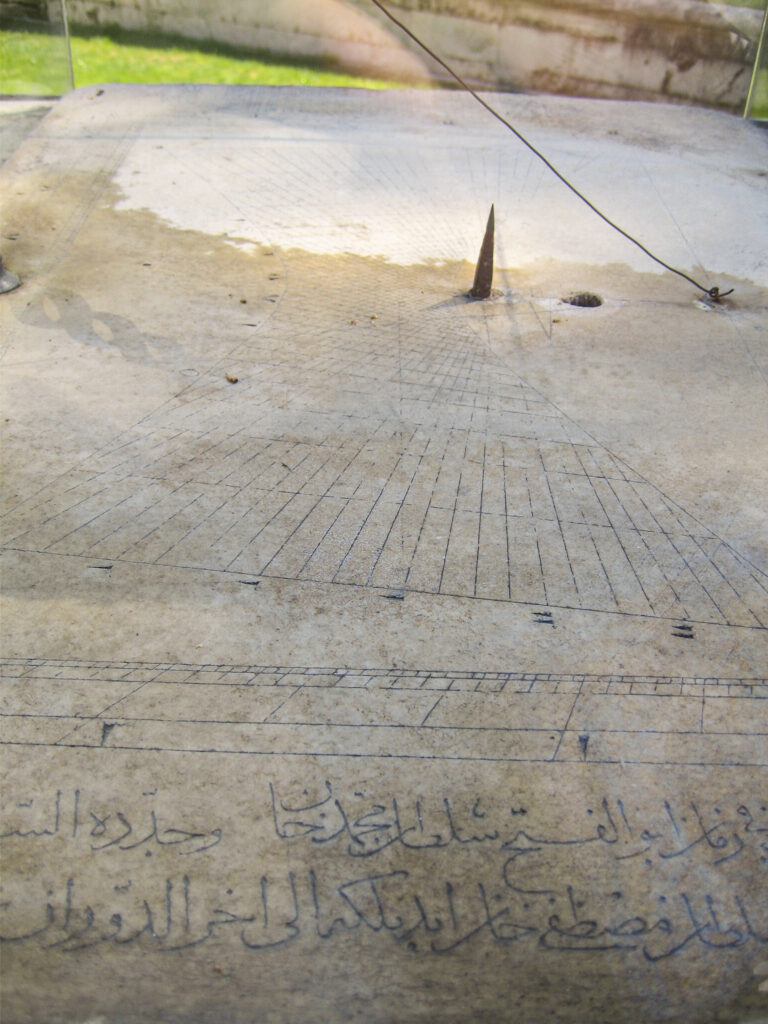
The Privy Chamber (Has Oda) is a confusing term, because there were several rooms inside the Harem with similar names, but as far as I can tell the original Has Oda was built in the reign of Sultan Murad III (1574-1595) to house the most sacred relics of the Islamic world, which included the cloak of Mohammed, a hair of his beard, his personal weapons, etc. This room was so holy that even the Sultan was permitted to enter only once a year, on the 15th of Ramadan.
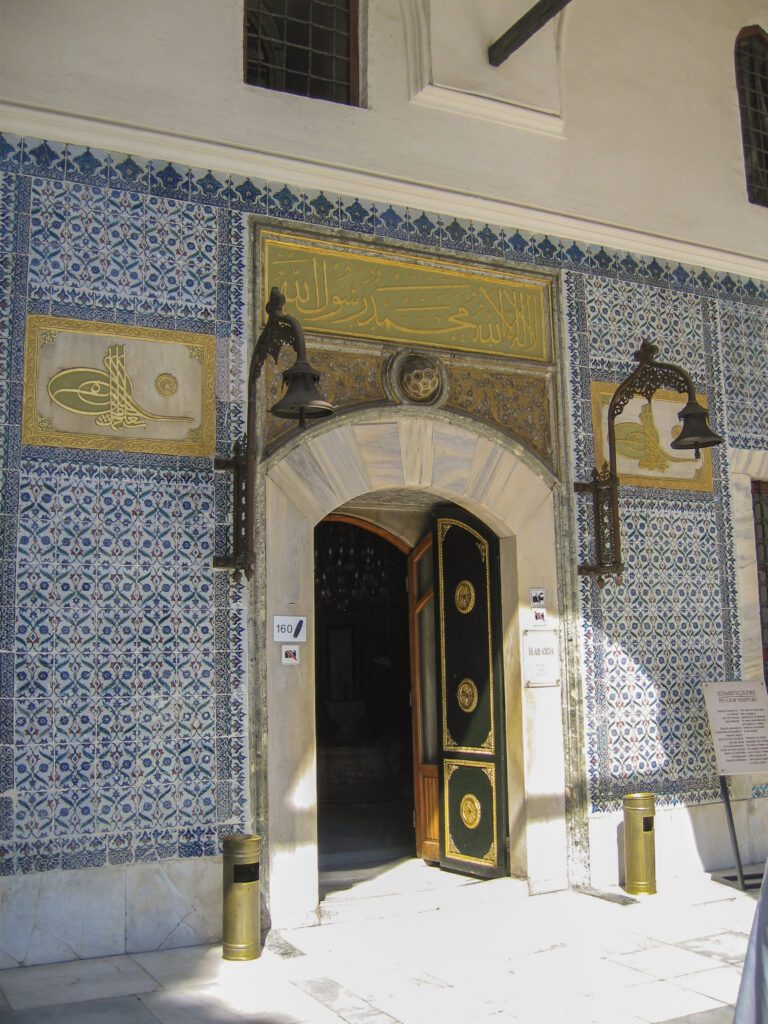
Next to the Audience Chamber but of much later origin is the Enderun Library, built in 1719 on order of Sultan Ahmed III for use by the officials of his household, so it was also known as the Library of Sultan Ahmed III. I found it interesting mainly for the elaborate drinking fountain in front of the portico, which offered a place to quench one’s physical thirst before satisfying the thirst for knowledge.
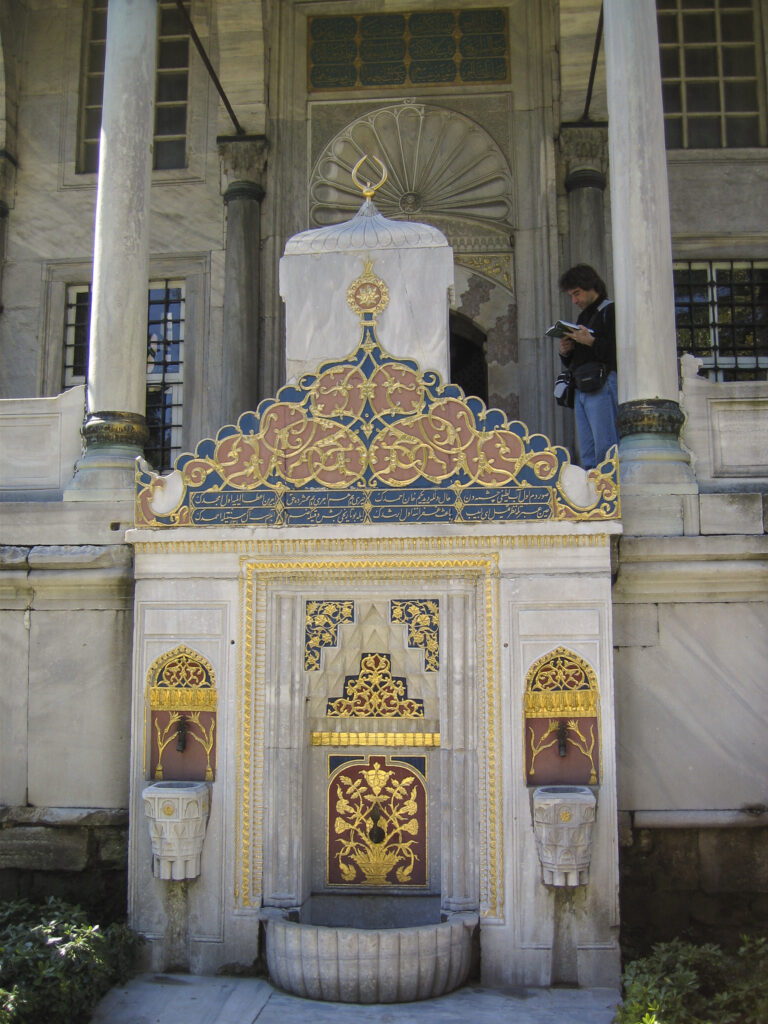
The Terrace Mosque and the Grand Pavilion, seen below, were latecomers to Topkapı. The former, also known as the Sofa Mosque, was added in the reign of Mahmud III (1808-39). The Grand Pavilion was built in 1840, after the reforming Sultan Abdulmejid I came to the throne. Abdulmejid deserted the Topkapı Palace as antiquated and built the new Dolmabahçe Palace on the Bosphorus to replace it, but evidently he felt obligated to visit the Topkapı now and then to perform the rituals of his office and placate the traditionalists, and he had the Grand Pavilion built for that purpose.
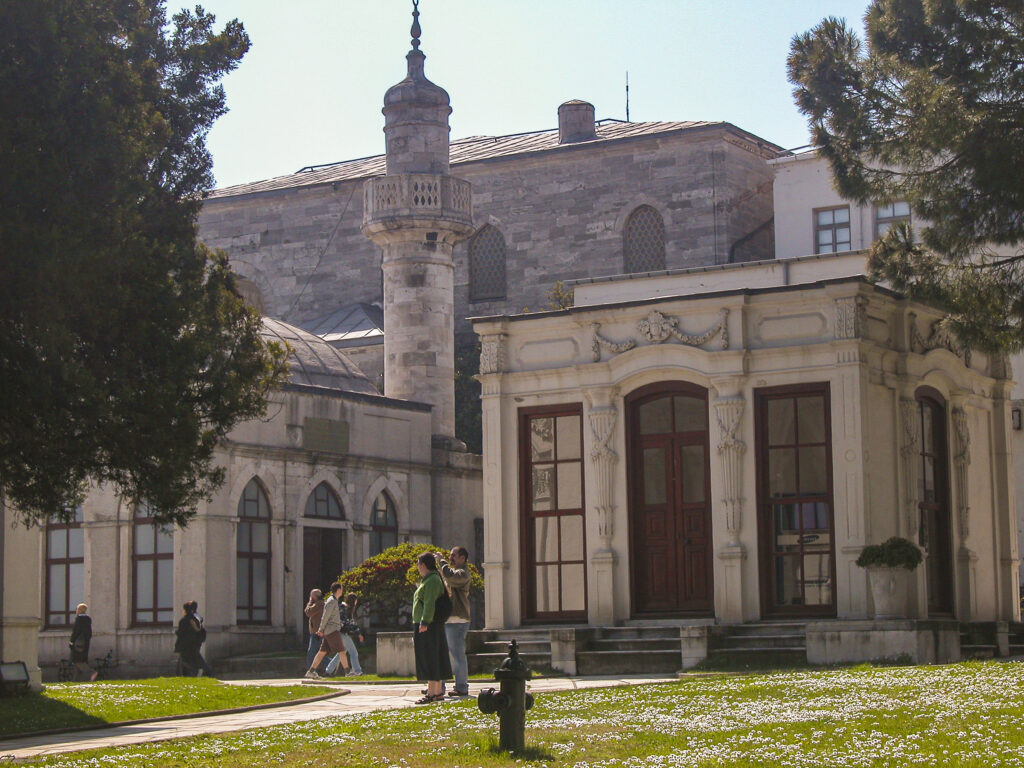
The Imperial Harem consisted of a series of buildings, apartments and courtyards on the west side of the Topkapı Palace. It connected to both the Second and Third Courtyards by various gates, doors and walkways, such as the Pebble Walk shown here. Access was controlled by turnstiles such as the ones at the end of the walkway, manned by eunuch guards who beheaded anyone trying to sneak in. (Actually, of course, the turnstiles are a modern addition. The eunuch guards, however, were quite real.)
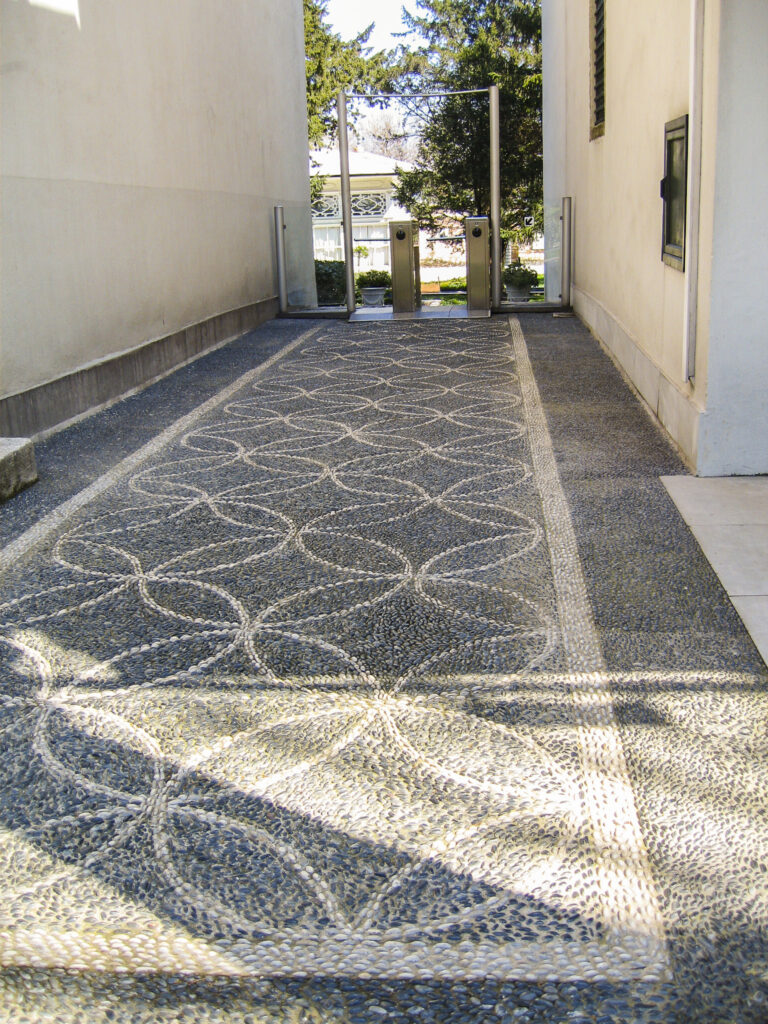
The harem was a huge place, with over 400 rooms, and it had to be, because it housed not only the Sultan, his wives (Islamic law permits up to 4) and concubines, of whom there could be as many as 300, and their children, but also the Sultan’s mother, the Valide Sultan, her familiars, and the servants, including the eunuchs, who served as administrators, menials and guards.
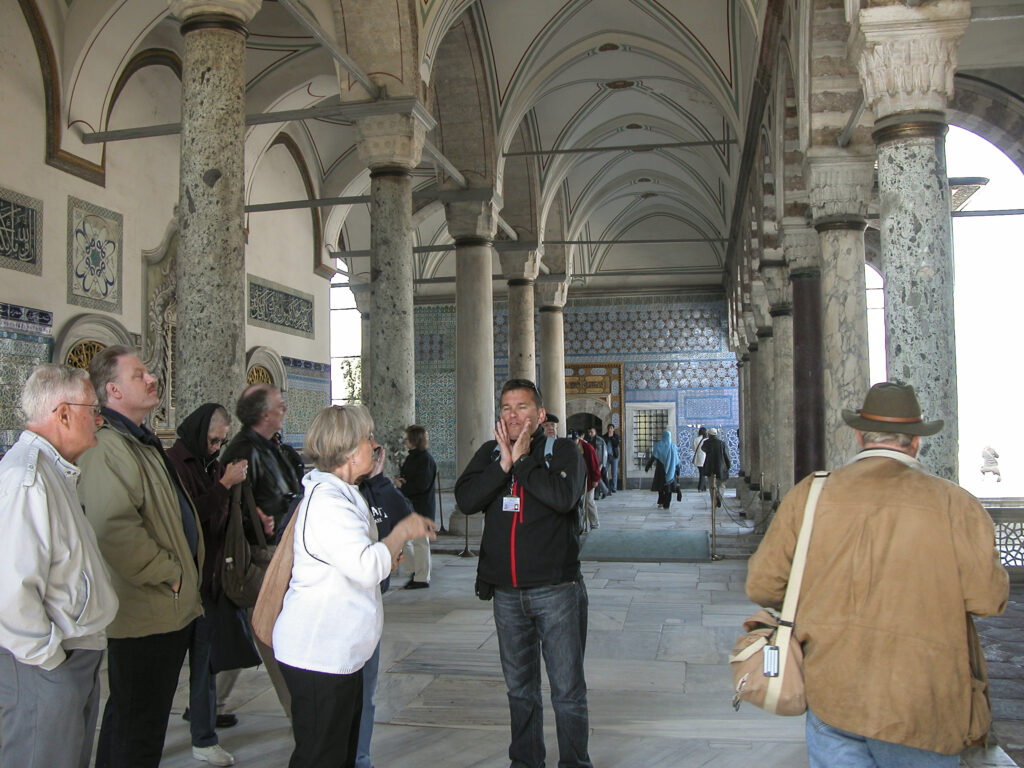
Actually the harem was not established in Topkapı Palace until the reign of Murad III (1574-95); until then it remained in the Old Palace, because Mehmet the Conqueror had ordained that women should not reside in the same place where government business was conducted. However, Hurrem, the favored wife of Suleiman the Magnificent, had already defied this rule by moving into Topkapı when the old harem burned down.
At this point I have to put in a disclaimer: The Topkapı harem is a maze. It puts to shame the Labyrinth of the Minotaur in Crete (which, by the way, the Ottomans conquered in the 17th century). Each category of persons living in the harem — concubines, eunuchs, princes, etc. — had its own quarters, clustered around a courtyard. These were connected by hallways, walkways, and in some cases, secret passages. Although there were of course signs and placards identifying the various rooms and courtyards we traversed, I was not always able to keep track of which was which, and the pace of our tour did not allow keeping extremely detailed notes, so there may be gaps or errors in identifying some of the rooms and courtyards shown here.
The largest courtyard in the harem was the Courtyard of the Valide Sultan or Queen Mother, the mother of the reigning sultan. Other than the Sultan himself, the Valide Sultan was the center of gravity in the harem and usually exerted considerable influence over the Sultan. In fact, during the period 1533-1636 the Valide Sultans were so influential that the period is sometimes referred to as “the Sultanate of Women.”
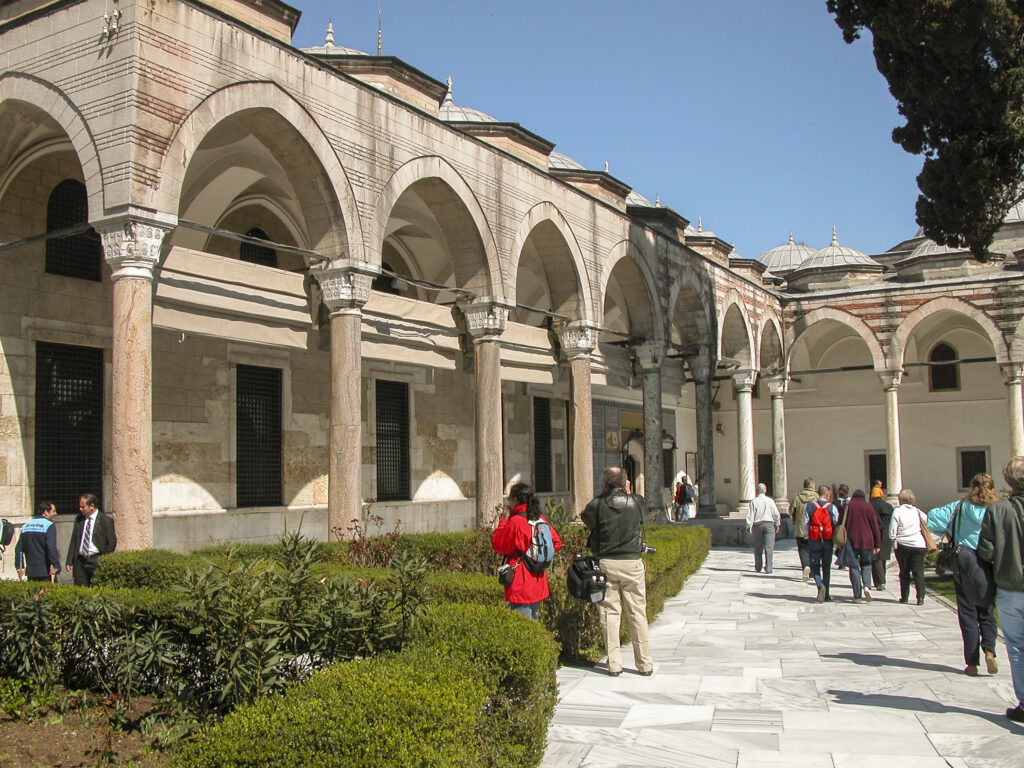
The south section of the harem, nearest the Second Courtyard and the Tower of Justice, contained the “working” areas – quarters of the eunuchs and women slaves, kitchen, pantry, laundry, hospital, school, etc.; the northern section contained the private apartments of the royal family. Down the length of the family quarters, from the Courtyard of the Black Eunuchs to the Privy Chamber (Has Oda) ran a corridor called the Golden Road (Altınyol). It provided the Sultan a convenient path of access to the Courtyard of the Valide Sultan, the Courtyard of the Chief Consort, and the apartments of the princes, as well as the Sultan’s own chambers.
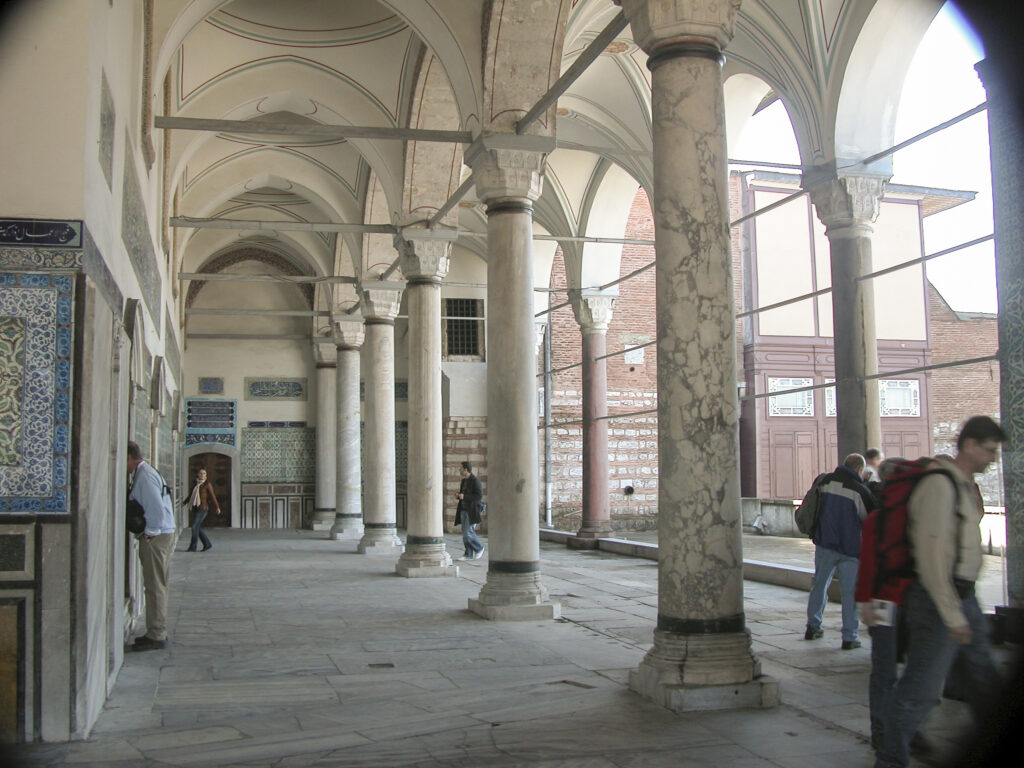
The exterior surfaces of the harem are decorated with gorgeous tile panels and gilded window grates, and occasionally fountains, as seen below.
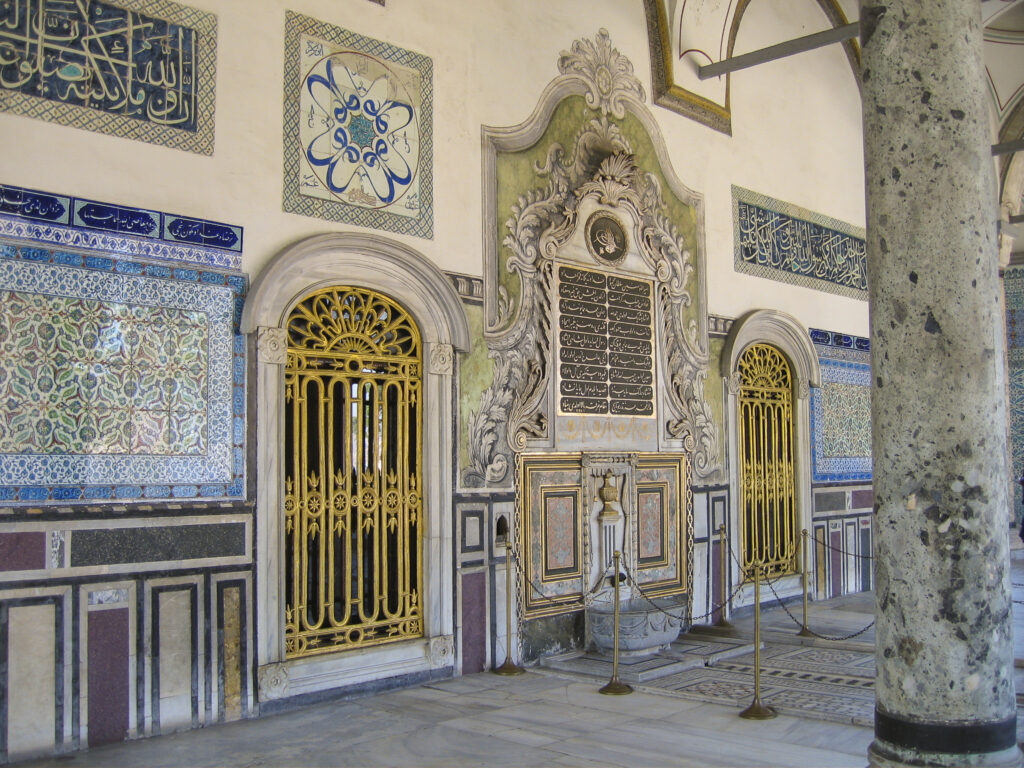
Other than members of the Sultan’s family, uncastrated males were prohibited access to the harem, on pain of death. I can never look at these pictures without being reminded of Mika Waltari’s novel The Wanderer, in which the protagonist’s scheming and faithless wife, who becomes fortune-teller to Suleiman the Magnificent’s wife Hurrem, violates the taboo by taking her lover with her into the harem in the guise of a eunuch, and both are garroted by the Sultan’s executioners for that, as well as for telling bogus fortunes.
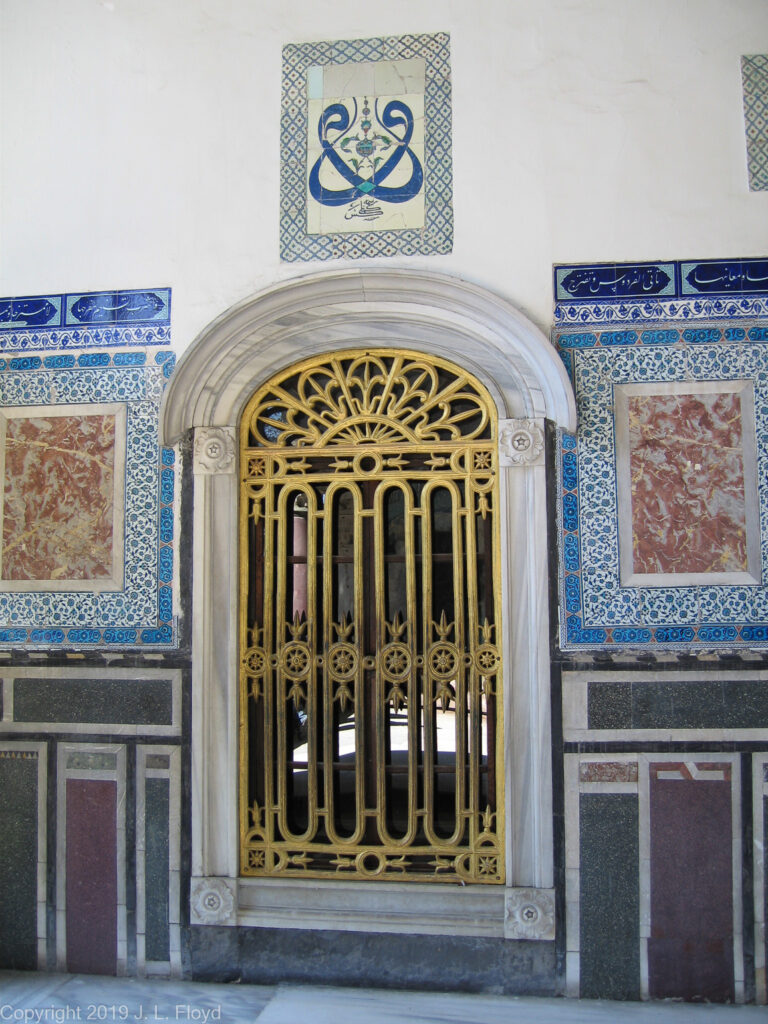
The interiors of the harem rooms typically had high ceilings with magnificent stained-glass windows around the upper half of the room and intricately carved wooden shutters at ground level, and gorgeous ceramic tiles filling the wall spaces between them.
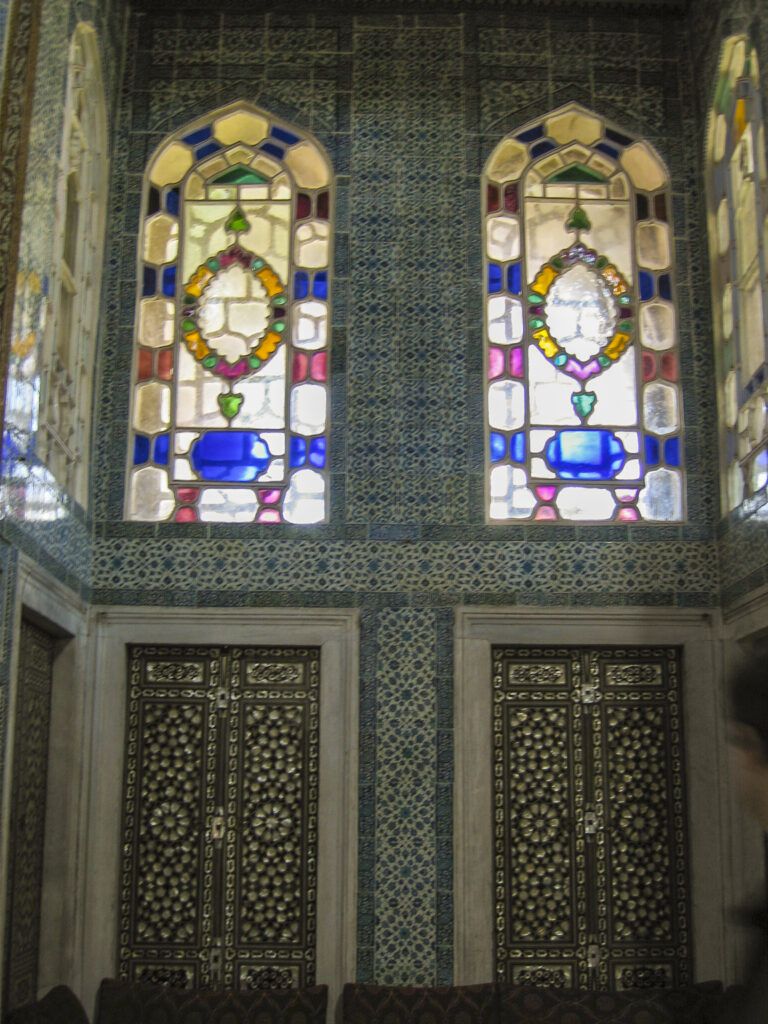
The carved wooden shutters opened to admit air and light, supplementing the illumination provided by the stained-glass windows.
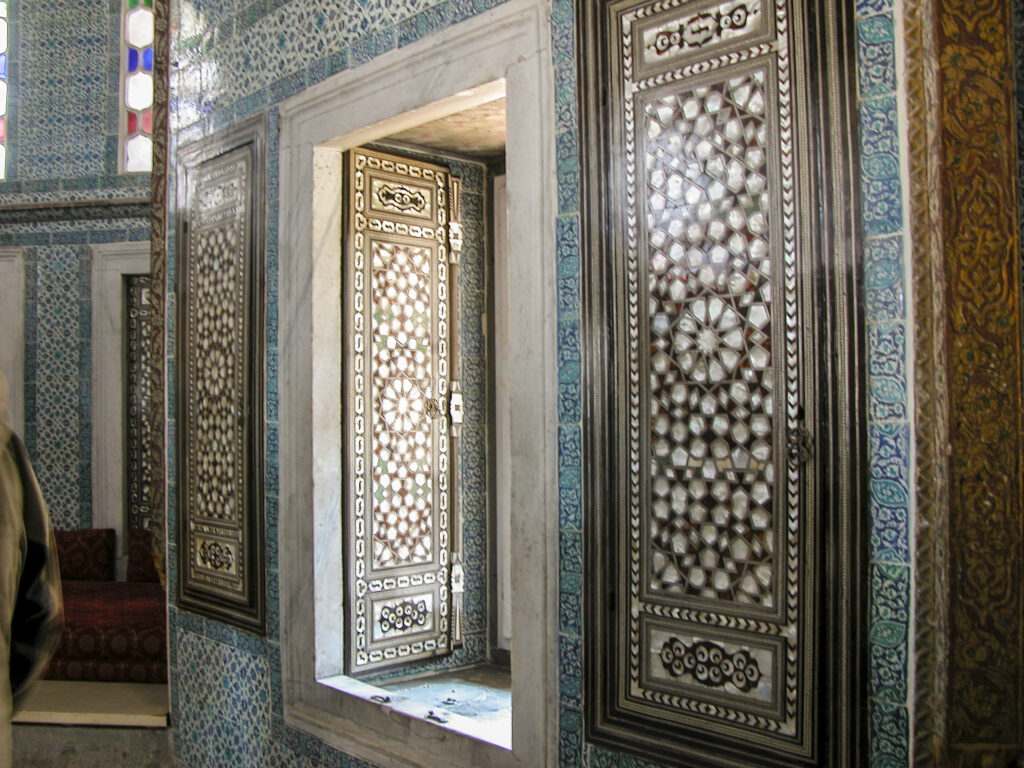
Chambers serving as living quarters frequently had walls with recessed bays filled with expansive beds or sofas, to all appearances ideal settings for libidinous indulgences.
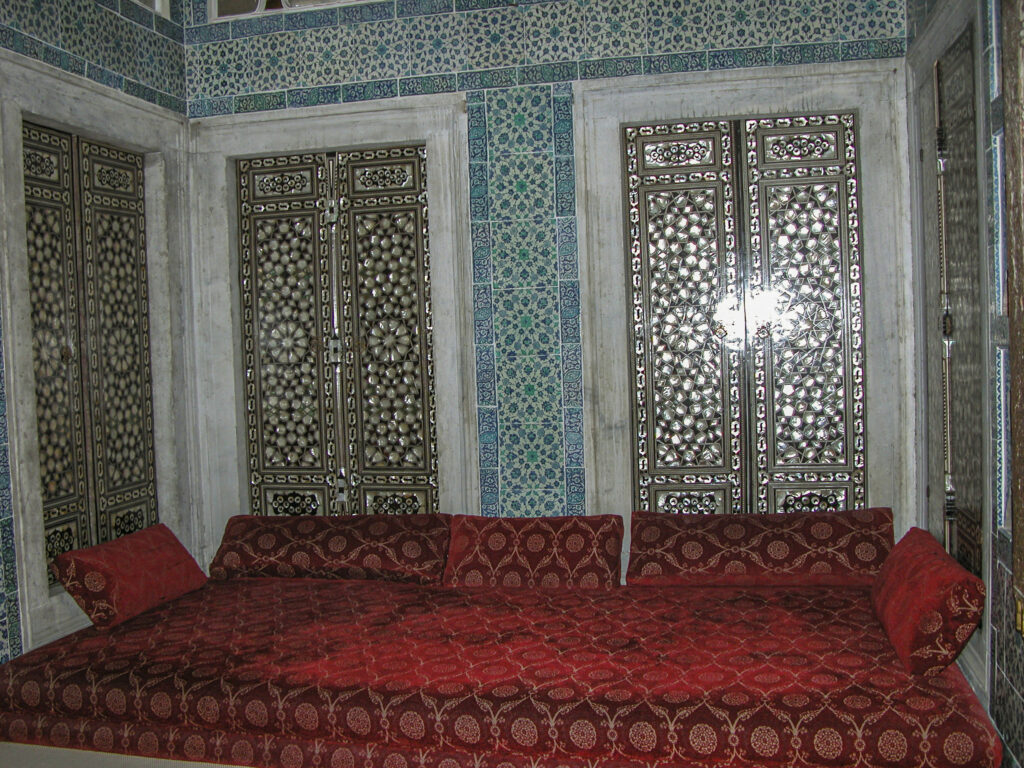
As one might expect, enormous canopied beds were also among the furnishings in the Sultan’s apartments. But what really drew my interest here was the design of the fireplace. I found the conical hoods of the Ottoman fireplaces quite striking and a little bizarre. I’m not sure whether the design was unique to the Ottoman Empire or was a common feature of early modern dwellings in Eastern Europe and the Middle East, but I expect it fulfilled the purpose of keeping the Sultan and his bedmates warm.
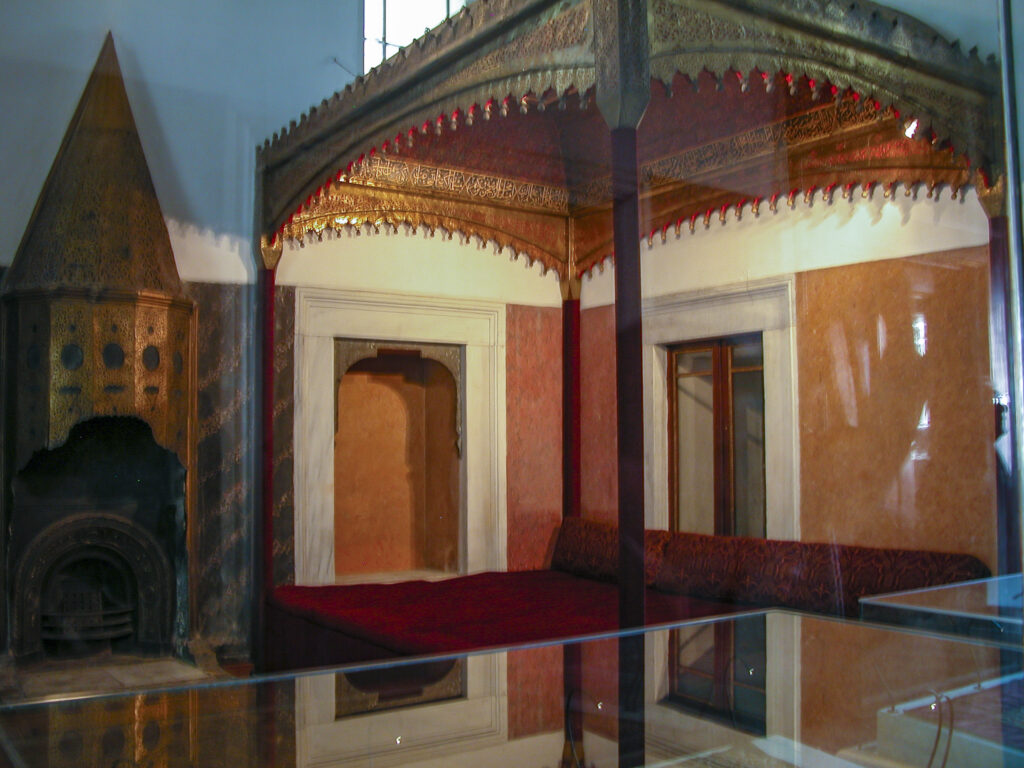
Each Sultan from Suleiman the Magnificent on added his own stamp to the harem, with new pavilions, courts and motifs.
Outside the Harem, on the north side of the Fourth Courtyard, stands the Circumcision Room (Sünnet Odası), a summer kiosk built by Sultan Ibrahim I in 1640 to serve as a chamber for circumcising newborn princes, which was usually done on the seventh day after birth.
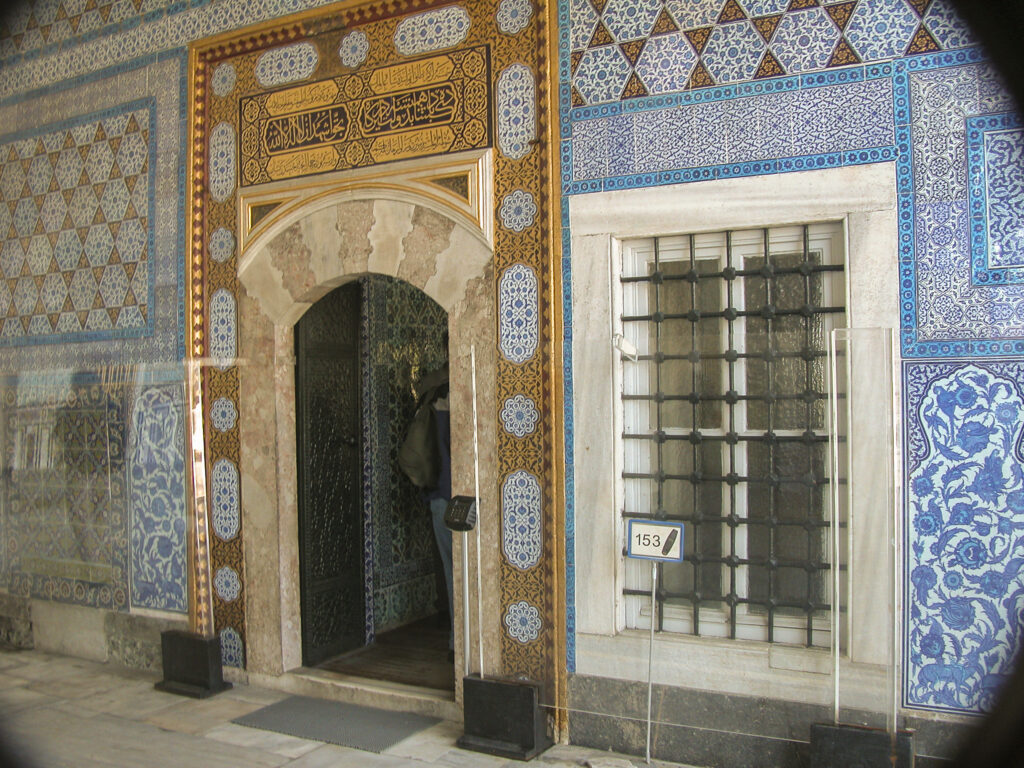
The Circumcision Room features some of the rarest and finest blue-and-white tiles in the harem. In the early 17th century Ottoman tiles were heavily influenced by Ming China motifs.
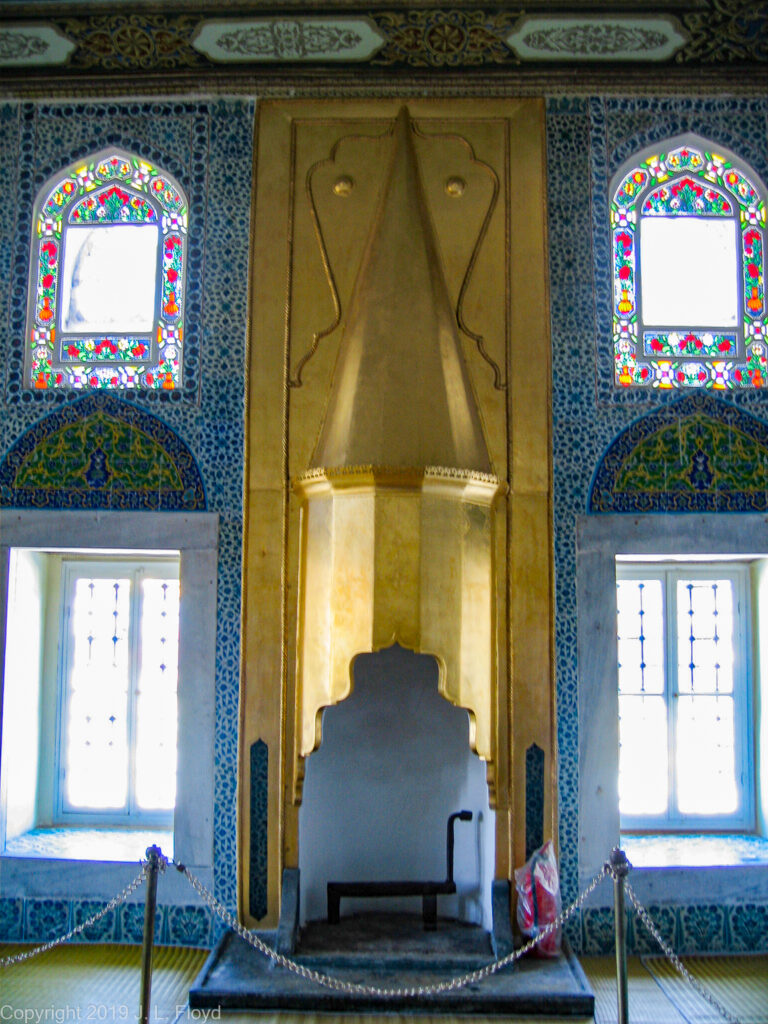
The Circumcision Room also had a number of beautiful stained-glass windows, as in the previous photo and the next, which features a closer look at one of the best.
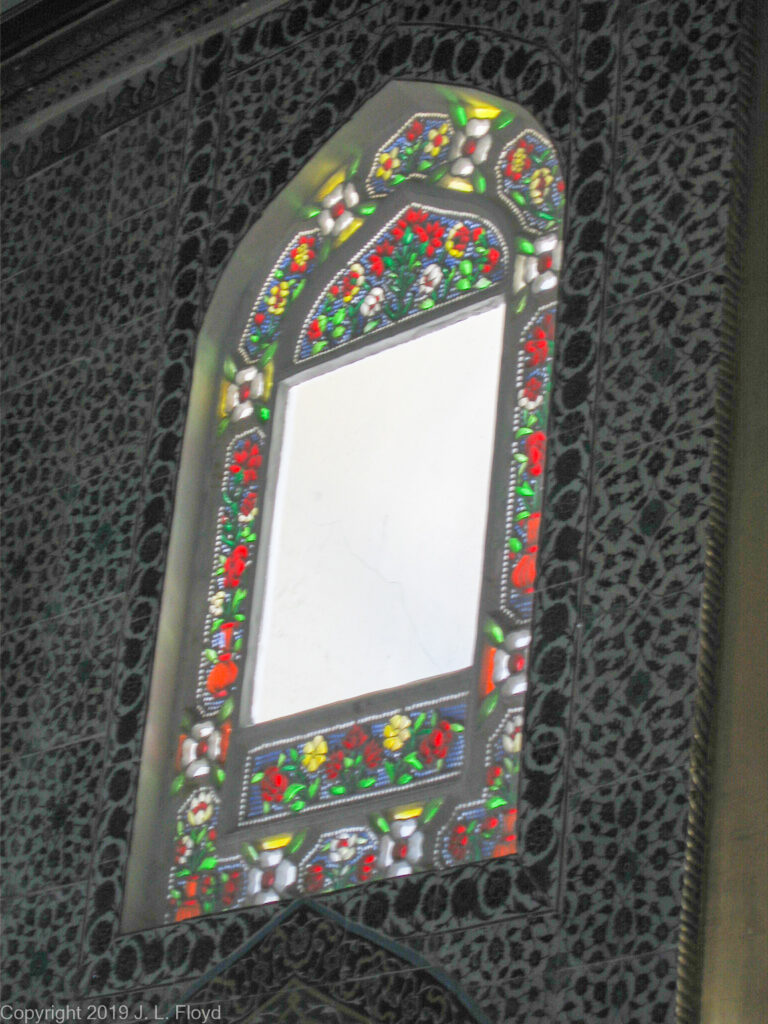
On a terrace in the northwest corner of the Fourth Courtyard stands an exquisite pavilion built to commemorate the Ottoman victory over the Safavid Persians, and recapture of Baghdad, in 1638. The Persians had conceded Ottoman control of Baghdad in a treaty with Suleiman the Magnificent in 1555, but in 1624 Shah Abbas I had seized Baghdad and slaughtered the Sunni inhabitants in an effort to make the city permanantly a Shiite stronghold. Several Ottoman attempts to retake it failed until finally Sultan Murad IV assumed personal command of the Ottoman armies and, after besieging Baghdad for 39 days, took it again, this time for keeps.
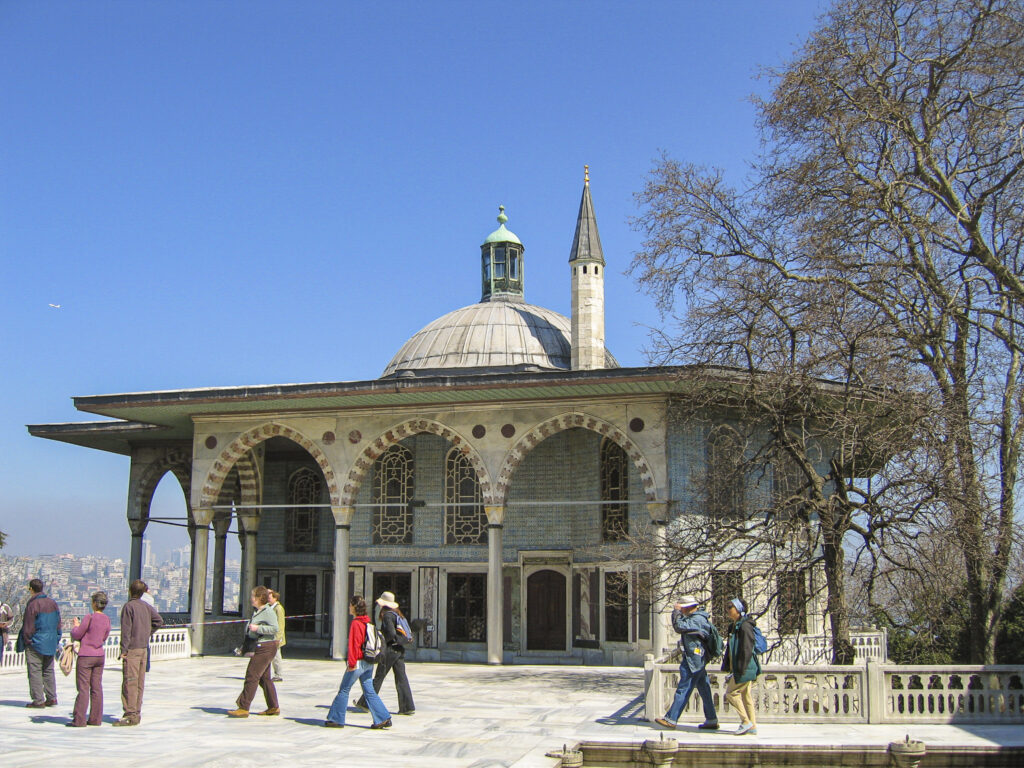
Murad IV died of cirrhosis of the liver in 1640, at the age of 27, and was succeeded by his brother Ibrahim.
Since the reign of Murad I, from 1362, newly-enthroned Sultans had practiced the custom of killing all their brothers to pre-empt struggles over the succession. Mehmed the Conqueror had gone so far as to codify this tradition into law. The first sultan to abandon the tradition of royal fratricide was Ahmed I, builder of the Blue Mosque. Having no sons at the time of his accession in 1603, Ahmed refrained from killing his brother Mustafa because that would endanger the succession. (Ahmed was only 13 at the time and it was not yet known whether he was capable of producing offspring.) Ahmed eventually had three sons, but when he died Mustafa became Sultan anyway. Unfortunately Mustafa turned out to be mentally unstable – he became known as Mustafa the Mad – and was deposed in favor of Ahmed I’s son Osman in 1618. However, Osman II provoked the ire of the janissaries and was assassinated in 1622, whereupon Mustafa was reinstated as Sultan. Proving no more stable than before, Mustafa was dethroned after a year and replaced by another son of Ahmed I, Murad IV. Mustafa was imprisoned in the Old Palace until his death in 1639.
Murad IV was only 11 at the time of his accession, and he only assumed personal rule in 1632. He proved to be little less eccentric than Mustafa, but rather more capable. He banned alcohol, tobacco and coffee in Constantinople on pain of death, and personally enforced his edict, roaming the city incognito to seek out offenders and beheading them on the spot when he caught them. He also like to sit in a kiosk by the water and shoot arrows at passersby who rowed their boats too close to the palace. On the other hand, he led the Ottoman forces to victory against the Safavid Persians in the late 1630s. Ironically, for a person who had banned alcohol and personally enforced the ban, he died of cirrhosis of the liver in 1640, at the age of 27.
Murad IV also seems to have reinstated the tradition of murdering his brothers, three of them, and none of his sons survived infancy. He intended to execute his one remaining brother, Ibrahim, but refrained from doing so in response to the appeal of their mother, Kösem Sultan.
Ibrahim turned out to be quite as mad as Mustafa, if not more so. However, one of his more level-headed accomplishments was the construction of the Iftar Kiosk, a small pavilion with a gilded cradle-vault roof near the Baghdad Kiosk, with a splendid view overlooking the Bosphorus and the Golden Horn. Legend has it that the Sultan made a habit of breaking his fast during Ramadan while seated there. It’s easy to understand why; I wouldn’t have minded having dinner there myself, but the palace kitchen wouldn’t deliver kebabs, and we had to move on.
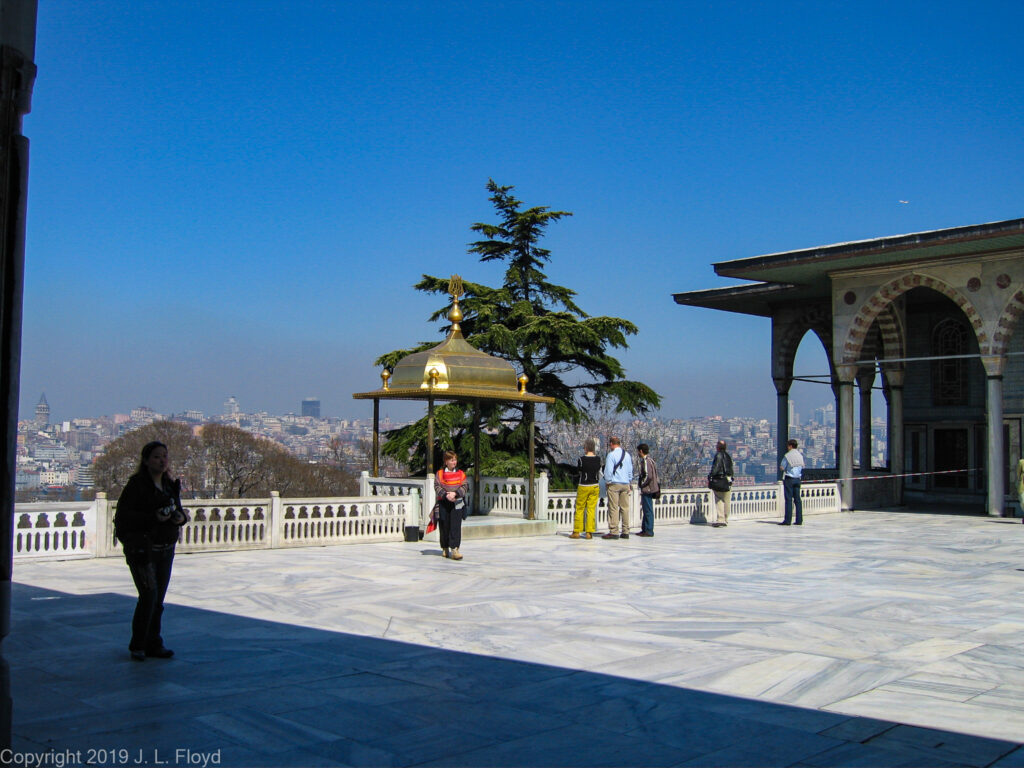
The Iftar Pavilion and the Baghdad Kiosk share the same terrace with this exquisite little fountain, which was not operating while we were there because the pool was empty. The entire terrace seems to have been a legacy of Ibrahim’s sultanate, an agreeable anomaly in a reign that was otherwise catastrophic. For more about that, you’ll have to wait for the end of this post.
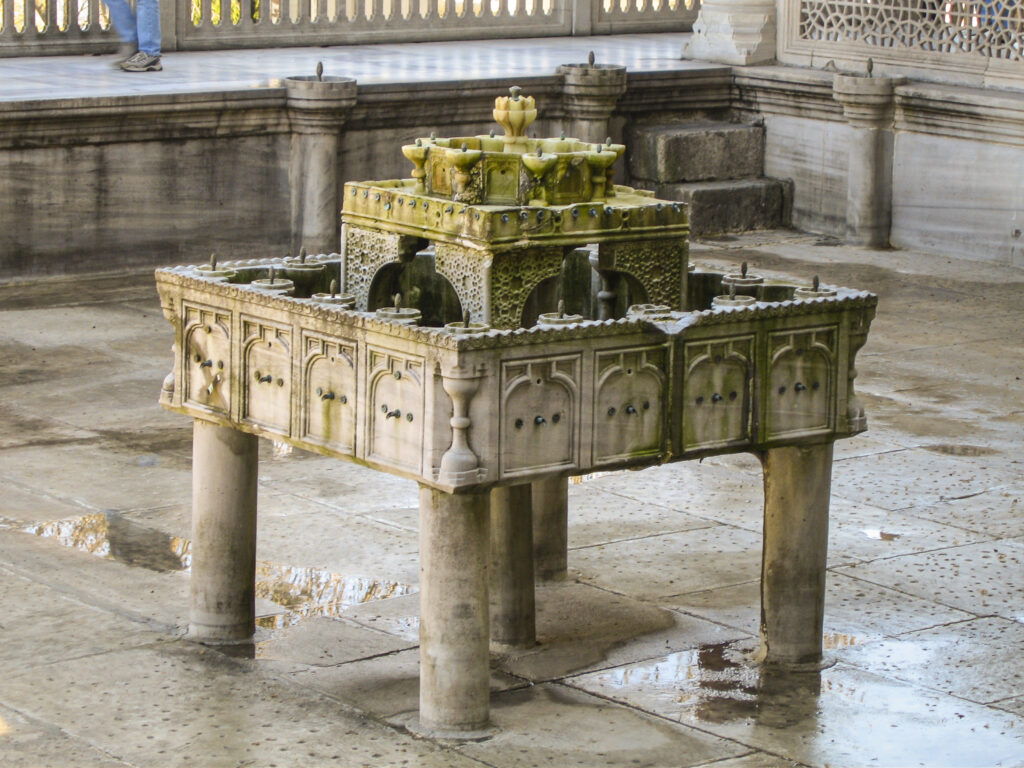
Surrounding Topkapı Palace on the west, north and east is the lush and verdant expanse of Gülhane Park, oldest and largest public park in Istanbul. Sandie was able to capture this view of the north end of the park from one of the terraces in the Fourth Court. In the center of the picture, framed in the trees, is the Column of the Goths, the oldest Roman monument in the city, possibly even predating the time of Constantine the Great. A nearly illegible inscription on the base commemorates a victory of the Romans over the Goths, but which victory is uncertain.
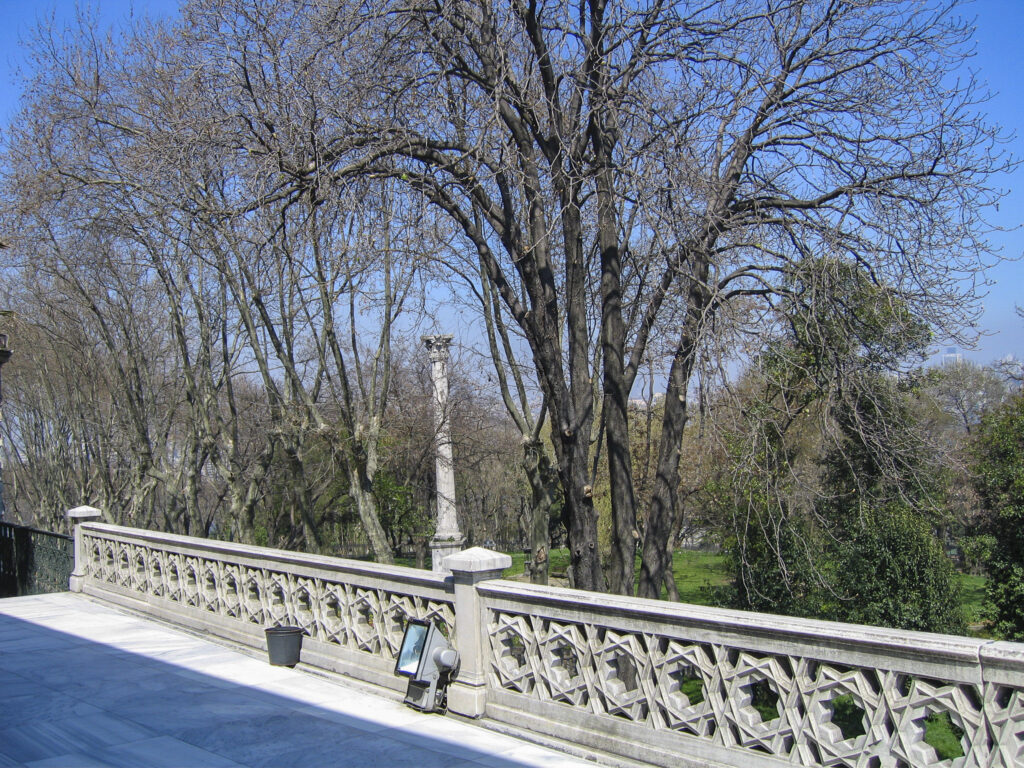
In addition to the view, we greatly enjoyed the stone balustrade of this terrace with its elegant eight-pointed star design.
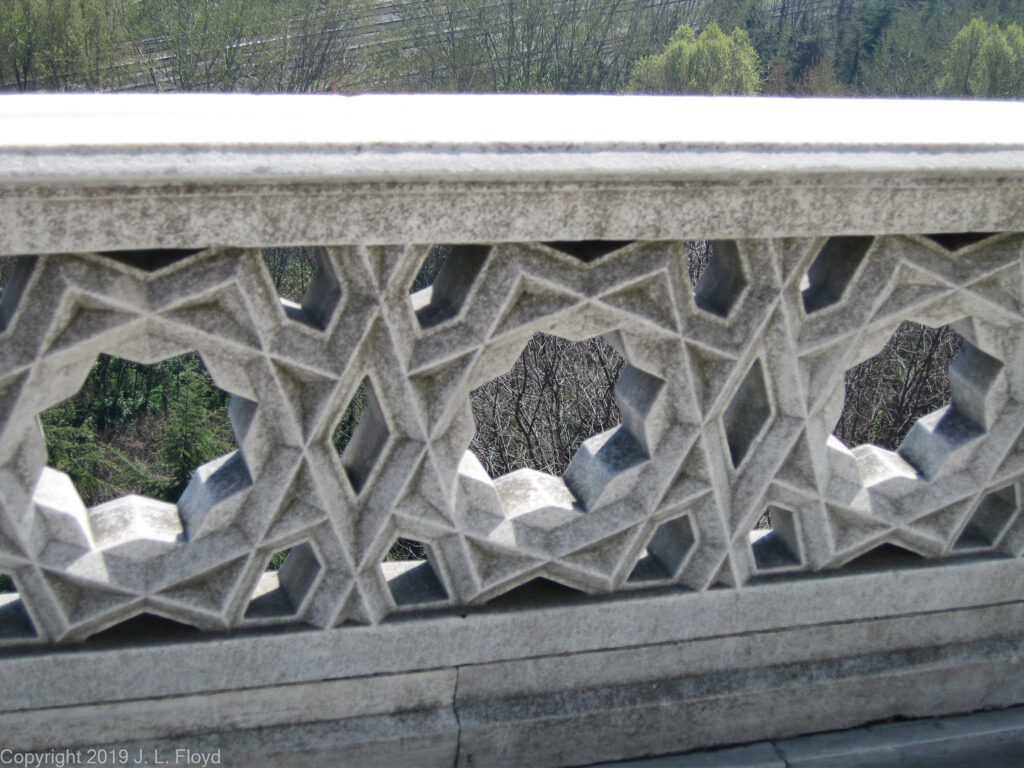
The Topkapı Palace provides some of the most magnificent views of Istanbul that can be obtained. To the east, one can look out over the Bosphorus, with a view of Asia on the far shore.
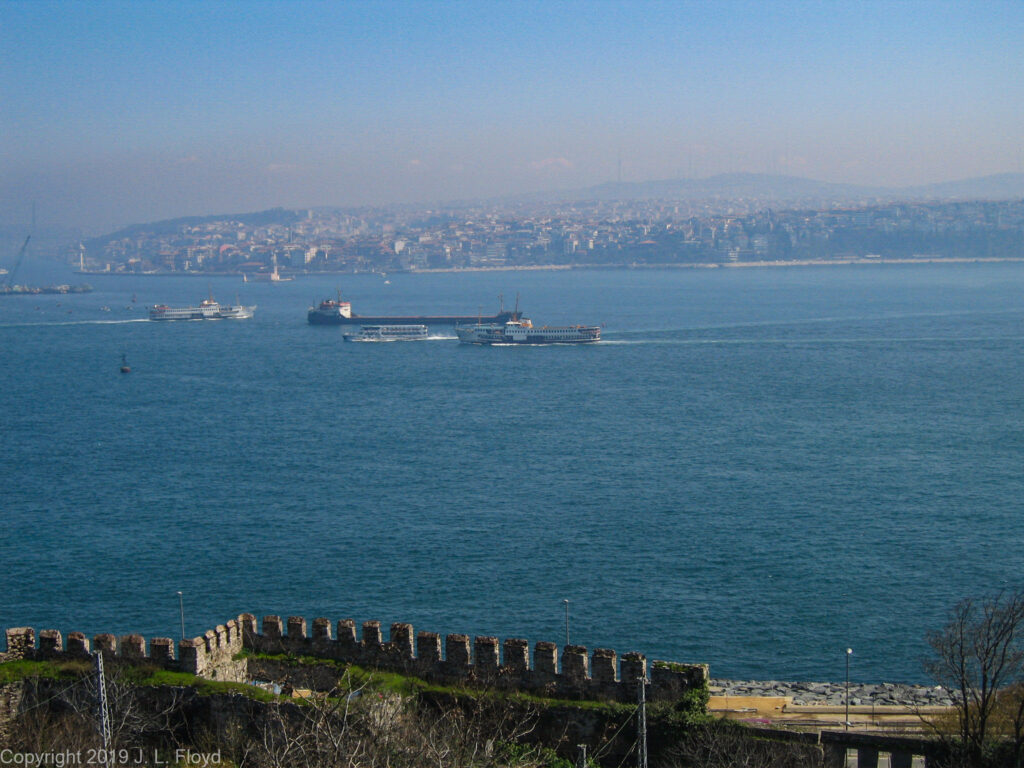
To the west of the palace, on the Third Hill of Istanbul, towers the Süleymaniye Mosque, which unfortunately we were not able to visit. It was the supreme architectural achievement of Sultan Suleiman the Magnificent, who chose as its designer the foremost Ottoman architect of the sixteenth century, Mimar Sinan. Sinan took his inspiration from Hagia Sofia as well as Islamic precedents. The Süleymaniye Mosque, although grandiose, is not as large as Hagia Sofia; however, like Hagia Sofia, its dome collapsed in an earthquake (1766). It has also been damaged by fire (1660) and by a munitions explosion in World War I; thus it has undergone repeated restorations, some of which have effaced the original work of Sinan. It also replaced the Old Palace, which had formerly housed the harem.
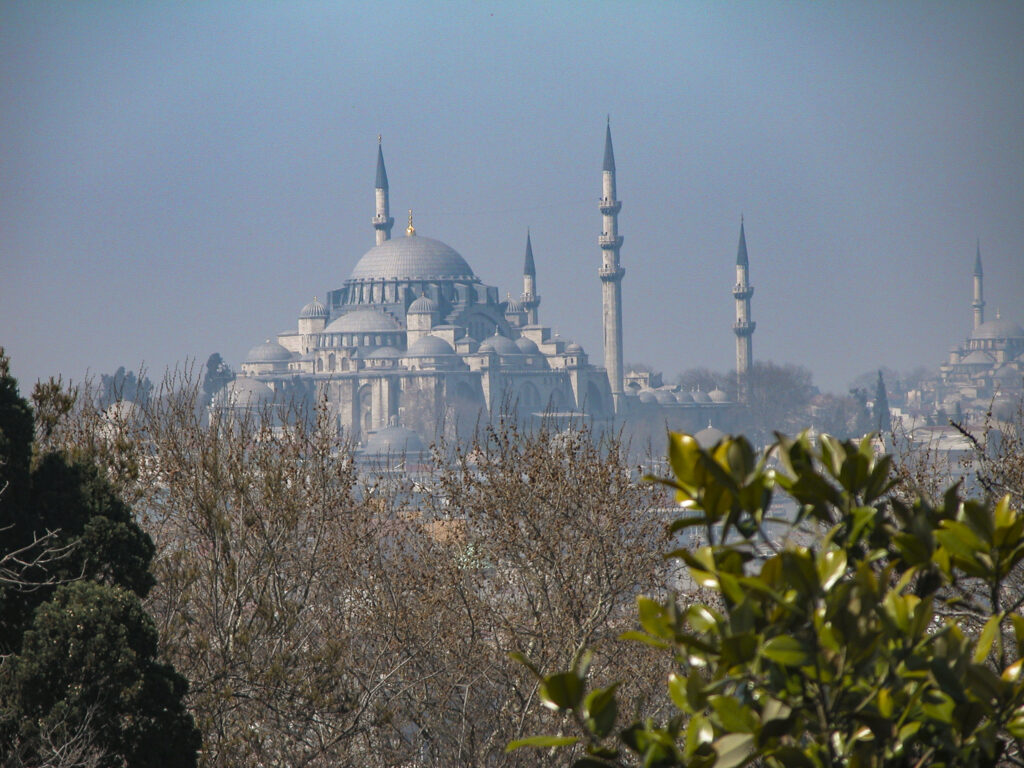
Looking north from the Iftar Pavilion, the eye is drawn northward across the Golden Horn to Beyoğlu and its tallest landmark, the Galata Tower.
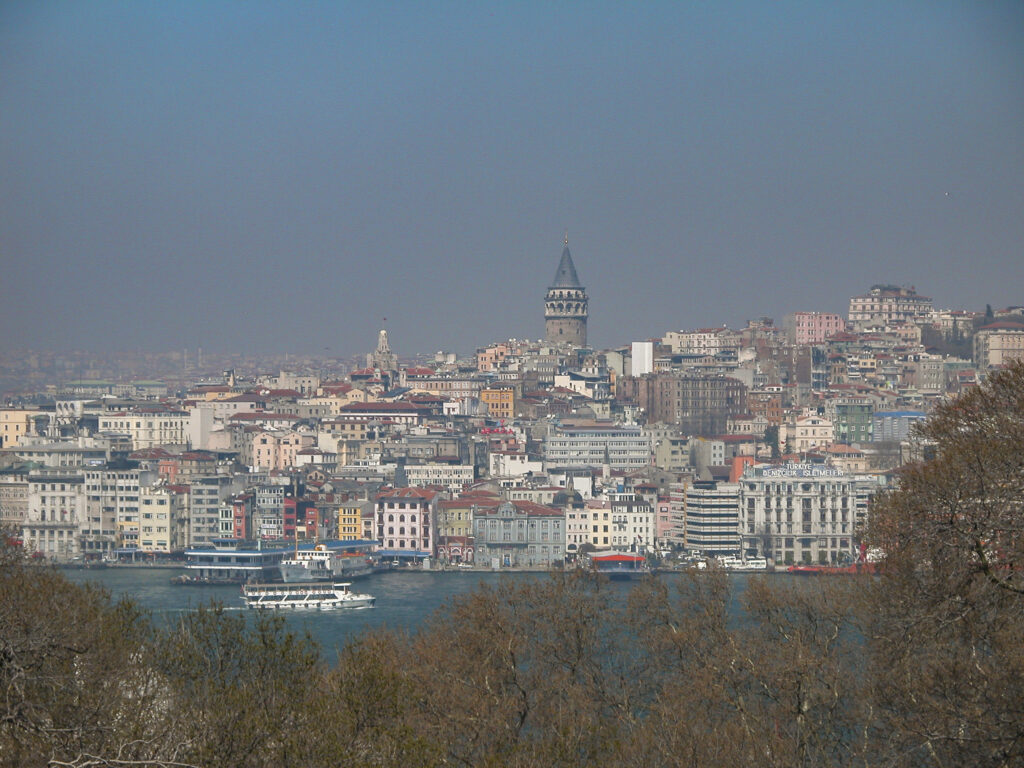
If you’re still wondering why the reign of Sultan Ibrahim (1640-48) was such a disaster, part of the explanation surely lies in his early childhood. He was born in 1615 and was only two years old when his father, Sultan Ahmed I, died. As mentioned earlier, Sultan Ahmed had ended the custom of killing off his brothers upon ascending the throne, but the tradition of fratricide was replaced by something not much kinder: confinement in a secluded apartment in the palace, known as the kafes or cage, under close supervision, so that they could not engage in plots to usurp the throne. There they remained until the reigning Sultan died, allowing the eldest to succeed to the throne legitimately, or they themselves died without succeeding to the throne. Understandably, this kind of existence, with no normal social life, let alone exposure to imperial affairs or on-the-job training in governance, was not conducive either to the development of leadership skills or even of robust mental health. Ibrahim was the first to demonstrate this principle. His first reaction upon being informed that he was the new Sultan was to assume that his elder brother, Murad, a known homicidal paranoiac, had laid a trap for him so as to secure his execution. Upon seeing Murad’s dead body, he agreed to assume the Sultanate, but left the mundane business of government largely to his mother, Kösem Sultan, and an able Grand Vizier, Kara Mustafa Pasha. He devoted himself mostly to the pleasures of procreation, with the encouragement of his mother, who procured him concubines suited to his tastes, which ran to extremely corpulent women, one of them reputedly weighing 330 pounds. This arrangement fell apart in 1644, when Kösem fell out with Kara Mustafa and Ibrahim fell increasingly under the influence of palace favorites, with the result that the Kara Mustafa was executed, Kösem was exiled from the palace, the treasury was emptied, and a war rashly begun with Venice provoked a Venetian blockade of the Dardanelles, threatening the capital with starvation. By 1648 the game was up; the janissaries revolted, the elders deliberated, and Ibrahim was deposed, imprisoned and then strangled. Ibrahim’s 7-year-old son Mehmed succeeded to the throne.
